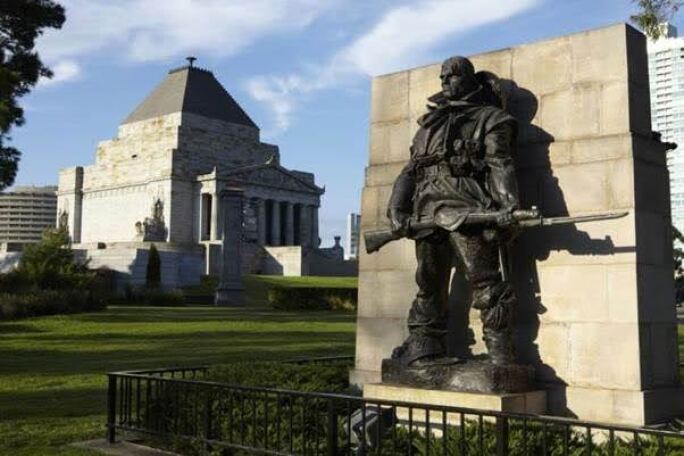From a Distinguished British Collection, Wipers is one of an impressive trio of war sculptures by Charles Sargeant Jagger which Sotheby’s is honoured to present in our Modern & Contemporary Evening Sale, along with Driver (lot 50) and The Artillery Captain (lot 52). Jagger’s unique ability to portray powerfully realistic images of war is unparalleled, and each of the three sculptures offered here are related to iconic memorials. The Driver and The Artillery Captain form integral parts of Jagger’s masterpiece, the Royal Artillery Memorial at Hyde Park Corner in London, while Wipers is from the Hoylake and West Kirby War Memorial in Cheshire. This sculpture is one of only six casts to exist of Wipers, and so the appearance of this sculpture at auction is an incredibly rare event. In their moving dignity, emotive intensity and faithful portrayal, they remain as relevant today as they were when first created over a century ago.

Derived from his first major public commission for the Hoylake and West Kirby War Memorial in Cheshire, Wipers is one of Charles Sargeant Jagger’s most recognisable works. In 1919, Jagger began work on Soldier on Defence for the memorial, a project that was to take until 1922 to complete, and part of a much broader national movement to commemorate the lives lost in the First World War. The Hoylake and West Kirby War Memorial was revealed on 16 December 1922 by the Earl of Birkenhead with 5,000 people in attendance.
Wipers sits on the east face of the Hoylake and West Kirby War Memorial, which itself consists of a round-topped granite obelisk, with buttresses on either side of its base. The original design was by the architects Hall and Glover, and lists the names of the fallen, as well as dates and epitaphs. On the opposite side to Wipers stands a robed woman holding a baby: she represents peace and the soldier represents war, standing equal on either side.
"... the peacetime dress is absolutely determined... [which] limits my ability to make anything artistic' where as the soldier is 'garbed for the rigours of winter and trench life."
The title drawn from soldiers’ name for Ypres, one of the main battle sites, the bronze Wipers maquette captures the raw spirit of the trenches with remarkable immediacy. The sculpture depicts a full-length infantry soldier standing guard with a standard issue .303 rifle with the bayonet fixed. He is dressed for winter conditions, there is a gas mask around his neck, and bullets have left marks on his helmet, indicated the hardships that he has been through. The soldier’s determination, dishevelled appearance, and the discarded German pickelhaube at his feet further underscore the harsh realities of conflict. Yet through its pyramidal composition, a technique Jagger frequently employed in his work, the figure remains a symbol of strength and perseverance. His approach here avoids any patriotic sentiment, instead presenting a heroic but deeply human image of the British Tommy, much as he would later achieve with the Royal Artillery Memorial and the GWR Memorial at Paddington Station.
Inspired in part by the ancient Egyptian figures he had seen in the collection of the British Museum, Jagger presents the very ordinary Tommy as a solemn, watchful figure, especially suitable for a commission to commemorate the recently deceased. Charles Sargeant Jagger himself served as a private in the Artists Rifles and as a Lieutenant in the Worcester Regiment. He was wounded in the trenches and received the Military Cross for his gallant efforts.
"Different meanings will be read in this as in all genuine works of art. One meaning that came to me was that the great gun was the symbol of all war in that, once war was started, nothing could stop the doom related in the stauary below, just as nothing could stop what would come from a howitzer once the lever was pulled."
Born near Rotherham in 1885, Jagger began his trade as a silver-engraving apprenticeship aged fourteen while studying art part-time. In 1903, he won a scholarship to the Royal College of Art to study sculpture, and then he secured a further scholarship to study at the British School in Rome, and then Venice. This gave him a basis in classical language and antiquity, which he went on to teach as Professor of Drawing at Sheffield. Both his studying and teaching came to a premature end due to the outbreak of war.

Wipers is an image of strength, and thus perhaps owes something to the work of Sir Frank Brangwyn. In his studies of dockers and sailors, and in his WWI work, Brangwyn’s powerful figures have a presence that is echoed in Wipers. It has even been suggested that the pose may owe something to Maurice Neumont’s famous French war poster On ne passe pas (1918).
A cast of Wipers was commissioned by H.R.H. The Prince of Wales in 1921, demonstrating the early popularity of the model. Four further casts were made in 1935, with an additional cast following in 1938 and it was realised in both bronze and plaster. A recasting of Wipers now forms part of the Drivers and Wipers Memorial at the Shrine of Remembrance in Melbourne. It was the acclaim and recognition that Jagger received for the Hoylake and West Kirby War Memorial which lead to the larger commission of the Royal Artillery Memorial at Hyde Park Corner.